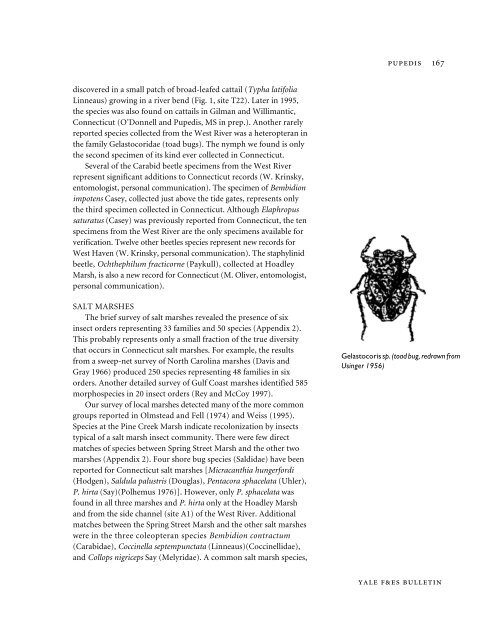Aquatic Insects of the West River and Salt Marshes ... - Yale University
Aquatic Insects of the West River and Salt Marshes ... - Yale University
Aquatic Insects of the West River and Salt Marshes ... - Yale University
You also want an ePaper? Increase the reach of your titles
YUMPU automatically turns print PDFs into web optimized ePapers that Google loves.
PUPEDIS 167discovered in a small patch <strong>of</strong> broad-leafed cattail (Typha latifoliaLinneaus) growing in a river bend (Fig. 1, site T22). Later in 1995,<strong>the</strong> species was also found on cattails in Gilman <strong>and</strong> Willimantic,Connecticut (O’Donnell <strong>and</strong> Pupedis, MS in prep.). Ano<strong>the</strong>r rarelyreported species collected from <strong>the</strong> <strong>West</strong> <strong>River</strong> was a heteropteran in<strong>the</strong> family Gelastocoridae (toad bugs). The nymph we found is only<strong>the</strong> second specimen <strong>of</strong> its kind ever collected in Connecticut.Several <strong>of</strong> <strong>the</strong> Carabid beetle specimens from <strong>the</strong> <strong>West</strong> <strong>River</strong>represent significant additions to Connecticut records (W. Krinsky,entomologist, personal communication). The specimen <strong>of</strong> Bembidionimpotens Casey, collected just above <strong>the</strong> tide gates, represents only<strong>the</strong> third specimen collected in Connecticut. Although Elaphropussaturatus (Casey) was previously reported from Connecticut, <strong>the</strong> tenspecimens from <strong>the</strong> <strong>West</strong> <strong>River</strong> are <strong>the</strong> only specimens available forverification. Twelve o<strong>the</strong>r beetles species represent new records for<strong>West</strong> Haven (W. Krinsky, personal communication). The staphylinidbeetle, Och<strong>the</strong>philum fracticorne (Paykull), collected at HoadleyMarsh, is also a new record for Connecticut (M. Oliver, entomologist,personal communication).SALT MARSHESThe brief survey <strong>of</strong> salt marshes revealed <strong>the</strong> presence <strong>of</strong> sixinsect orders representing 33 families <strong>and</strong> 50 species (Appendix 2).This probably represents only a small fraction <strong>of</strong> <strong>the</strong> true diversitythat occurs in Connecticut salt marshes. For example, <strong>the</strong> resultsfrom a sweep-net survey <strong>of</strong> North Carolina marshes (Davis <strong>and</strong>Gray 1966) produced 250 species representing 48 families in sixorders. Ano<strong>the</strong>r detailed survey <strong>of</strong> Gulf Coast marshes identified 585morphospecies in 20 insect orders (Rey <strong>and</strong> McCoy 1997).Our survey <strong>of</strong> local marshes detected many <strong>of</strong> <strong>the</strong> more commongroups reported in Olmstead <strong>and</strong> Fell (1974) <strong>and</strong> Weiss (1995).Species at <strong>the</strong> Pine Creek Marsh indicate recolonization by insectstypical <strong>of</strong> a salt marsh insect community. There were few directmatches <strong>of</strong> species between Spring Street Marsh <strong>and</strong> <strong>the</strong> o<strong>the</strong>r twomarshes (Appendix 2). Four shore bug species (Saldidae) have beenreported for Connecticut salt marshes [Micracanthia hungerfordi(Hodgen), Saldula palustris (Douglas), Pentacora sphacelata (Uhler),P. hirta (Say)(Polhemus 1976)]. However, only P. sphacelata wasfound in all three marshes <strong>and</strong> P. hirta only at <strong>the</strong> Hoadley Marsh<strong>and</strong> from <strong>the</strong> side channel (site A1) <strong>of</strong> <strong>the</strong> <strong>West</strong> <strong>River</strong>. Additionalmatches between <strong>the</strong> Spring Street Marsh <strong>and</strong> <strong>the</strong> o<strong>the</strong>r salt marsheswere in <strong>the</strong> three coleopteran species Bembidion contractum(Carabidae), Coccinella septempunctata (Linneaus)(Coccinellidae),<strong>and</strong> Collops nigriceps Say (Melyridae). A common salt marsh species,Gelastocoris sp. (toad bug, redrawn fromUsinger 1956)YALE F&ES BULLETIN
















